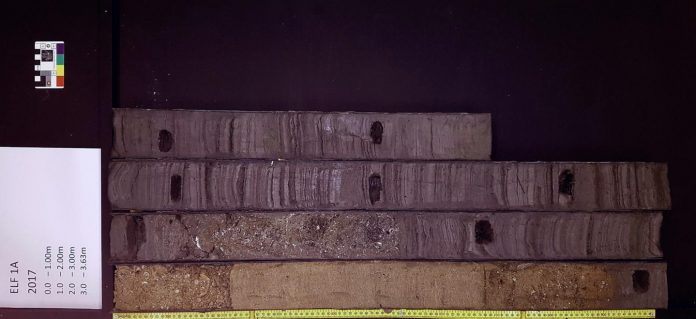
IMAGE: The sediment of which the sedaDNA was studied
view more
Credit: Dr Martin Bates, UWTSD
Thousands of years ago the UK was physically joined to the rest of Europe through an area known as Doggerland. However, a marine inundation took place during the mid-holocene, separating the British landmass from the rest of Europe, which is now covered by the North Sea.
Scientists from the School of Life Sciences at the University of Warwick have studied sedimentary ancient DNA (sedaDNA) from sediment deposits in the southern North Sea, an area which has not previously been linked to a tsunami that occurred 8150 years ago.
The paper, led by the University of Bradford and involving Universities of Warwick, Wales St. Trinity David, St. Andrews, Cork, Aberystwyth, Tartu as well as the Smithsonian and Natural History Museum, ‘Multi-Proxy Characterisation of the Storegga Tsunami and Its Impact on the Early Holocene Landscapes of the Southern North Sea’, published in the Journal Geosciences, sees Life Scientists from the University of Warwick work specifically on the sedimentary ancient DNA from Doggerland.
A number of innovative breakthroughs were achieved by the University of Warwick scientists in terms of analysing the sedaDNA. One of these was the concept of biogenomic mass, where for the first time they were able to see the how the biomass changes with events, evidence of this presented in the paper refers to the large woody mass of trees from the tsunami found in the DNA of the ancient sediment.
New ways of authenticating the sedaDNA were also developed, as current methods of authentication do not apply to sedaDNA which has been damaged whilst under the sea for thousands of years because there is too little information for each individual species. Researchers therefore came up with a new way, metagenomic assessment methodology, whereby the characteristic damage found at the ends of ancient DNA molecules is collectively analysed across all species rather than one.
Alongside this a key part of analysing the sedaDNA is to determine whether or not it was deposited in situ or has moved over time. This led researchers to develop statistical methods to establish which scenario was appropriate, using stratigraphic integrity they were able to determine that the sedaDNA in the sediment deposits had not moved a massive amount since deposition by assessing the biomolecules vertical movement in the core column of the sedaDNA.
Identifying which organisms the ancient fragmented molecules of DNA came from is also challenging because often there is nothing to directly compare. In a fourth innovation the researchers refined algorithms to define these regions of “dark phylogenetic space” from where organisms must have originated overcome this issue.
Professor Robin Allaby from the School of Life Sciences at the University of Warwick comments: “This study represents an exciting milestone for sedimentary ancient DNA studies establishing a number of breakthrough methods to reconstruct an 8,150 year old environmental catastrophe in the lands that existed before the North Sea flooded them away into history.”
Professor Vince Gaffney from the School of Archaeological and Forensic Sciences at the University of Bradford said: “Exploring Doggerland, the lost landscape underneath the North Sea, is one of the last great archaeological challenges in Europe. This work demonstrates that an interdisciplinary team of archaeologists and scientists can bring this landscape back to life and even throw new light on one of prehistory’s great natural disasters, the Storegga Tsunami.
“The events leading up to the Storegga tsunami have many similarities to those of today. Climate is changing and this impacts on many aspects of society, especially in coastal locations.”
###
NOTES TO EDITORS:
High-res images available to view at:
https:/
Paper available to view at: https:/
For further information please contact:
Alice Scott
Media Relations Manager – Science
University of Warwick
Tel: +44 (0) 7920 531 221
E-mail: [email protected]
TDnews















